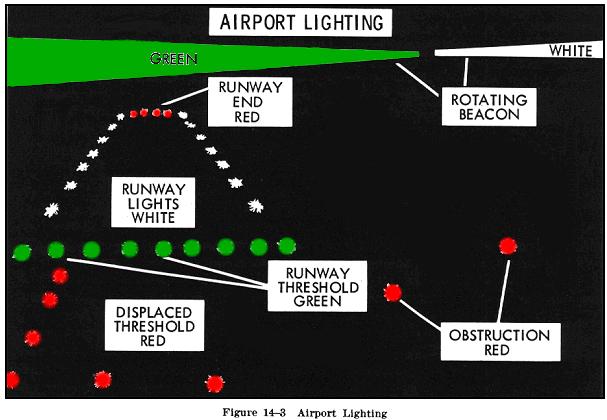
The light systems used for airports, runways, obstructions, and other visual aids at night are other important aspects of night flying.
Lighted airports located away from congested areas can be identified readily at night by the lights outlining the runways; however, airports located near or within large cities are often difficult to identify in the maze of lights. It is important not only to know the exact location of these airports relative to the city, but also to be able to identify these airports by the characteristics of their lighting pattern.
Aeronautical lights are designed and installed in a variety of colors and configurations, each having its own purpose. Although some are used during low ceiling and visibility (IFR) conditions, this discussion includes only the lights that are fundamental to VFR night operation (Fig. 14-3).

It is recommended that prior to night flight, particularly cross-country, the pilot check the availability and status of lighting systems at airports along the planned route and the destination airport. This information can be found on aeronautical charts and in the Airport/Facility Directory, and the status of each facility can be determined by reviewing pertinent Notices to Airmen.
A rotating beacon is used to indicate the location of an airport. Its vertical light distribution is such that it can be seen most effectively from one to three degrees above the horizontal; however, the light can also be seen well above and below this range. The beacon rotates at a constant speed, thus producing what appears to be a series of light flashes at regular intervals. These flashes may be one or two different colors which are used to identify various types of landing areas. For example:
Alternating white and green - lighted
land airports.
White alone - unlighted land airports.
Green alone - sometimes installed as
an aid to find a not too distant white and green beacon.
Military airports also have beacons flashing alternately white and green, but are differentiated from civil airports by dual peaked (two quick) white flashes between the intermittent green flashes.
Obstructions or areas considered hazardous to aerial navigation are indicated by beacons producing red flashes. Steady burning red lights are used to mark obstructions on or near airports and sometimes to supplement flashing lights on enroute obstructions. High intensity flashing white lights are now being used to mark some supporting structures of overhead transmission lines which stretch across rivers, chasms, and gorges. These high intensity lights are used also to identify tall structures, such as chimneys and towers, that are considered to be obstructions to air navigation.
As a result of the technological advancements in aviation, many runway lighting systems have become quite sophisticated to accommodate takeoffs and landings in various weather conditions. However, the pilot whose flying is limited to VFR conditions need be concerned only with the following basic lighting of runways and taxiways.
The basic runway lighting system consists of two straight parallel lines of runway edge lights defining the lateral limits of the runway. These lights are aviation white, although aviation yellow may be substituted for a distance of 2,000 feet from the far end of the runway to indicate a caution zone. At some airports the intensity of the runway edge lights can be adjusted to satisfy the individual needs of the pilot. The longitudinal limits of the runway are defined by straight lines of lights across the runway ends. At some airports the runway threshold lights are aviation green; and the runway end lights are aviation red.
At many airports the taxiways also are lighted. A taxiway edge lighting system consists of omnidirectional blue lights which outline the usable limits of taxi paths. Caution must be observed when taxiing, particularly at airports that are not equipped with taxiway lights. The use of the airplane's landing or taxiing lights is essential under these conditions.